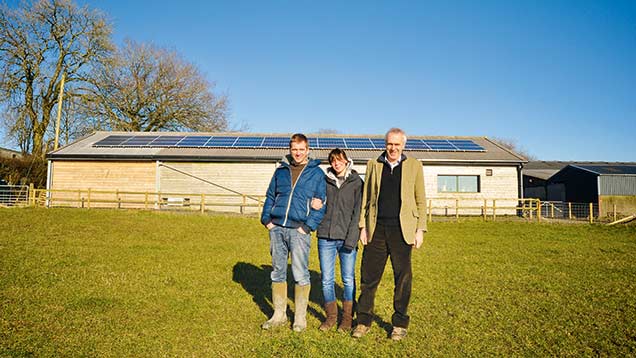Farm energy case study: Roof-mounted solar PV, Wales

One of the best ways to assess whether a renewable energy investment would work on your farm is to talk to others who have been through the process.
Paul Spackman quizzed five farmers who have been generating renewable energy for at least a year to hear their experiences and get their tips for others considering entering what is still a relatively new sector.
Solar power helps reduce cheese production costs on Patrick Holden’s Bwlchwernen Fawr near Lampeter.
Project overview
A 10kW roof-mounted solar PV system fitted to the south-facing roof of a cheese dairy at Patrick Holden’s 52ha organic farm, about 10 miles from the Ceredigion coast in west Wales. The array is made up of 42 Trina panels, Hilti rail and Sunny
Tri-power inverters.
See also: Farm energy case study: Small-scale wind project, Yorkshire
See also: Farm energy case study: Small-scale AD Norfolk
See also: Farm energy case study: Small-scale hydro, Dumfries
See also: Farm energy case study: Straw-fired biomass boilers, Arbroath
Ownership
Owned outright, funded entirely with a loan from Triodos bank. “It’s guaranteed income for 25 years, so is a very bankable borrowing proposition,” says Mr Holden.
Cost
The project cost about £25,000 in total, which included all equipment costs, installation and strengthening to the existing roof.
Timescale
Mr Holden says he had been thinking of installing solar for some time, but the impetus to go ahead came when the government announced plans to cut Fits from December 2011. “We rang Southern Solar as soon as we heard and they managed to complete installation just before the reductions came into force. It took just three and a half days to fit the system.”
Performance
The array has a predicted annual energy yield of 8,322kWh and Mr Holden says it has met expectations. “It’s been fault-free so far.”
Running costs
There have been no costs in the first three years of operation, although the panels may now need cleaning.
Net return
The site qualified for the higher Fits rate of 40.83p/kWh and Mr Holden says income from the Fits and electricity exported to the grid (worth 3.3p/kWh) has totalled about £8,000 since installation, plus there have been additional savings from electricity used on site.
“We initially worked on a 50:50 split between on-site use and export, as the peak demand in the dairy is generally during the middle of the day when the panels should be generating the highest output.”
Payback
Mr Holden says the project will pay for itself in five to six years, although the repayment period for the bank loan is over a slightly longer period.
Most difficult part
Installation was straightforward, although a structural survey of the building’s roof prior to installation deemed it unsuitable for additional load from the panels, so the steel Z-purlins had to be reinforced with timber.
Installation and commissioning of the system also had to be carefully planned around the activities of the dairy farm and cheesemaking, especially as the electricity had to be turned off temporarily.
Easier than expected
“The whole process actually turned out easier than we expected,” says Mr Holden. “The most difficult part was taking the decision to go ahead in the first place.”
Most useful advice
No particular advice stands out, however Mr Holden says it would have been useful to get more integrated renewable energy advice that could help tailor the most appropriate technologies and/or energy-saving measures to the specific characteristics and needs of the farm business.
Change anything?
“We’d have liked to put a larger capacity solar PV scheme in and had the roof space to do so, but were limited to 10kW by our single-phase supply. It would be better if the cost of upgrading power supplies could be shared between landowners and power companies, especially as farms of the future will be key sources of renewable energy generation.”
Advice to others
“Make sure you’ve got a decent roof structure that can support panels for 20 years or so, and ideally it needs to be roughly south-facing. Do the maths carefully on the payback, because even though the Fits have fallen, so too has the cost of the equipment. Installing solar PV is certainly the right thing for farms to do, as it saves money, generates income and reduces greenhouse gas emissions.”
Rating: 8/10
“There’s not much I can say against what we’ve done. I only wish we hadn’t been limited by our single-phase supply and could have put a larger system in.”
